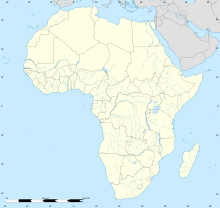This is an old revision of this page, as edited by KeyMen12 (talk | contribs) at 11:41, 25 November 2024. The present address (URL) is a permanent link to this revision, which may differ significantly from the current revision.
Revision as of 11:41, 25 November 2024 by KeyMen12 (talk | contribs)(diff) ← Previous revision | Latest revision (diff) | Newer revision → (diff) | This article, Winter Airfield, has recently been created via the Articles for creation process. Please check to see if the reviewer has accidentally left this template after accepting the draft and take appropriate action as necessary.
Reviewer tools: Inform author |
| Winter Airfield | |||||||||||
|---|---|---|---|---|---|---|---|---|---|---|---|
 Winter Airfield Winter Airfield | |||||||||||
| Summary | |||||||||||
| Airport type | Former airstrip (small) | ||||||||||
| Owner | Gustav Winter | ||||||||||
| Serves | Jandía Penisuela | ||||||||||
| Location | Puertito de la Cruz Village, Fuerteventura, Canary Island, Spain | ||||||||||
| Coordinates | 28°04′36″N 014°28′07″W / 28.07667°N 14.46861°W / 28.07667; -14.46861 | ||||||||||
| Map | |||||||||||
  | |||||||||||
| Runways | |||||||||||
| |||||||||||
Winter Airfield is an airstrip constructed by Gustav Winter, a German engineer and business man. It is located on the Canary Islands, Spain.
History
Winter Airfield was located on the Jandía Peninsula of Fuerteventura in the Canary Islands, Spain. It was constructed by German engineer Gustav Winter, either just before or shortly after World War II. The airfield featured a gravel or dirt runway measuring approximately 1,005 meters in length and 45 meters in width.
Gustav Winter, born in 1893 in Neustadt, Germany, moved to Spain in 1915. In 1924, he founded the CICER electricity plant in Las Palmas, Gran Canaria, which began operations in 1928. His involvement with the Jandía Peninsula began in 1933 when he signed a lease with the heirs of the Conde de Santa Coloma from Lanzarote. In 1937, Winter traveled to Berlin seeking funding for his projects.
 Puerto de la Cruz Airfield airstrip that looks similiar to Winter Airfield's.
Puerto de la Cruz Airfield airstrip that looks similiar to Winter Airfield's.
In the early 1930s, Winter purchased extensive land on the Jandía Peninsula, including the area around Cofete. He constructed Villa Winter, a large villa on the first slopes of the mountain, and undertook significant agricultural projects. The small village of Cofete grew, reaching over 100 inhabitants, many employed by Winter.
This airstrip was likely established to improve accessibility to this remote part of the island, which may have previously been harder to reach by land. Fuerteventura, due to its position in the Atlantic Ocean, has long been a stopover point for international flights, especially with the development of air travel in the 20th century.
World War II
The airfield's history is intertwined with various legends and speculations. Some narratives suggest that during World War II, the Jandía Peninsula served as a secret base for the German Navy's U-boats, utilizing volcanic lava tunnels along the coast. There are also claims that Winter's villa, located near the airfield, was used as a clinic where Nazi criminals underwent plastic surgery before relocating to South America. However, distinguishing fact from fiction in these accounts is challenging.
Post-War
After World War II, the airfield fell into disuse. Gustav Winter passed away in Las Palmas in 1971. His villa (Villa Winter) remained under private security until the early 1990s. Today, the remnants of Winter Airfield serve as a historical curiosity, reflecting a complex blend of documented history and local folklore.
References
- ^ "Winter Airstrip". Forgotten Airfields. Retrieved 24 November 2024.
- ^ "Puertito de la Cruz". Only Fuerteventura. Retrieved 20 October 2024.
- "Cofete Cemetery". Retrieved 20 October 2024.